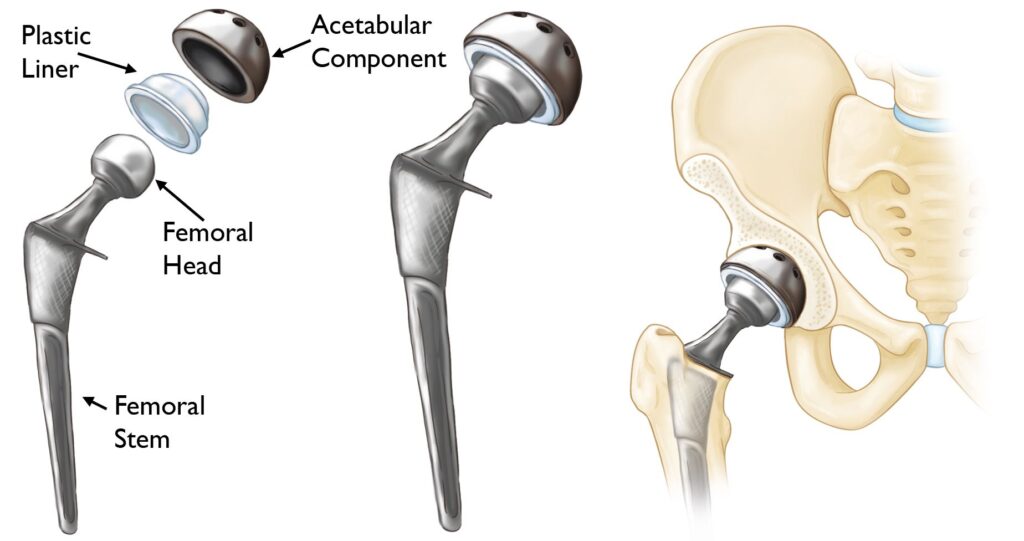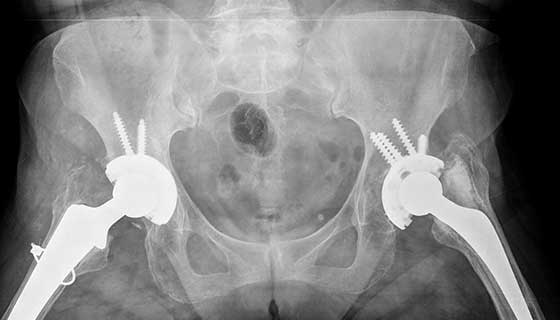Do you experience chronic hip pain that prevents you from performing simple daily activities, such as walking, sitting, or even sleeping comfortably?
Has your movement become so limited that it negatively impacts your independence and quality of life?
This suffering is not uncommon for millions worldwide, as hip joint wear or damage is a widespread problem that worsens with age or as a result of certain injuries and medical conditions.
In many advanced cases, when conservative treatments fail to provide adequate relief, total hip arthroplasty (THA) becomes the optimal solution to restore the joint’s normal function and radically alleviate pain.
This surgery is one of the most successful and effective orthopedic procedures, performed at Liva Hospital in Turkey, it restores patients’ freedom of movement and gives them a new opportunity to enjoy an active, pain-free life.

The Hip Joint: Why Does Damage Occur in the First Place?
The hip joint is one of the largest and most important joints in the human body.
It’s a ball-and-socket joint that allows for a wide range of motion in all directions and supports the weight of the upper body.
The joint consists of the head of the femur (the ball part) which rests within the acetabulum (the socket part) of the pelvis. These surfaces are covered with smooth cartilage that allows for smooth, frictionless movement.
Hip joint damage usually occurs due to the wear and tear of this cartilage, leading to bones rubbing against each other, causing severe pain, stiffness, and difficulty in movement.
Among the prominent causes of this damage is degenerative arthritis (Osteoarthritis), the most common form of arthritis where cartilage wears away over time.
Other causes include rheumatoid arthritis, avascular necrosis (where part of the femoral bone dies due to insufficient blood flow), in addition to severe hip injuries such as hip fractures.
In hip joint replacement surgery, the damaged parts of the bone and cartilage are removed and replaced with artificial components made of metal, ceramic, and polyethylene, giving you a new hip joint that functions smoothly and significantly reduces pain.
Are You a Candidate for Hip Joint Replacement Surgery?
The decision to undergo hip joint replacement surgery is not one to be taken lightly; it requires a precise and comprehensive medical evaluation.
Generally, you are considered a suitable candidate if you suffer from severe hip pain that does not respond to conservative treatments such as anti-inflammatory medications, physical therapy, or cortisone injections.
This pain must significantly affect your quality of life and limit your ability to perform daily activities such as walking, climbing stairs, or even dressing.
There is no specific age for hip joint replacement surgery; while often performed on older adults, it can be performed on younger patients suffering from conditions such as avascular necrosis or severe arthritis.
Your surgeon will assess your general health and perform tests such as X-rays, MRI, and blood tests to ensure you are healthy enough to withstand the surgery and recover from it.
Doctors at Liva Hospital in Turkey, for example, follow comprehensive evaluation protocols to ensure the best outcomes for their patients.
Preparing for Surgery
Thorough preparation before hip joint replacement surgery is a crucial factor in achieving the best results and reducing potential risks.
The preparation process often begins with a detailed medical evaluation by the anesthesiologist and surgeon, to assess your general health and determine the best anesthesia option.
You may be asked to undergo some routine tests such as blood tests, an electrocardiogram, and a chest X-ray.
It is essential to inform your doctor about all the medications and supplements you are currently taking, especially blood thinners, as you may need to stop some of them for a certain period before surgery to avoid bleeding.
You may also be asked to start light exercises to strengthen your upper body and hip muscles, which helps in the recovery process.
It is advisable to arrange for assistance at home after surgery, either from family members or friends, to ensure support during the initial recovery period.
Quitting smoking as far in advance as possible before surgery improves blood flow and promotes healing.
Adherence to these guidelines prepares your body and mind for surgery and contributes to a faster and smoother recovery.
What Happens During the Surgical Procedure?
Hip joint replacement surgery is a complex and precise surgical procedure that requires high skill from the surgeon and the medical team.
The operation is usually performed under general anesthesia or spinal (regional) anesthesia and takes between one and two hours.
The surgeon makes an incision in the hip area, which can be from the back, side, or front, depending on the surgeon’s preferred technique and the patient’s condition.
After reaching the joint, the head of the femur is separated from the pelvic socket. The surgeon then removes the damaged femoral head and any damaged cartilage or bone from the pelvic socket.
The pelvic socket is then prepared to receive the artificial component, which is either secured by press-fit (to allow bone growth around it) or using bone cement. Next, a metal stem is inserted into the femoral canal, and an artificial spherical head (usually ceramic or metal) is attached to it.
The new joint is then reassembled, and the surgeon ensures its stability and range of motion before closing the surgical incision.
This operation is performed in specialized centers like Liva Hospital in Turkey using the latest techniques to ensure accuracy and effectiveness.
Recovery and Rehabilitation Period
The recovery and rehabilitation period is an integral part of the success of hip joint replacement surgery.
Once the surgery is complete and your condition is stable, you will begin your recovery program. You will experience some pain after surgery, which will be effectively managed with appropriate medications.
The physical therapy program usually begins on the same day of surgery or the day after.
The physical therapist will teach you simple exercises to move the joint and improve circulation, and then help you sit up and walk using crutches or a walker.
The initial goal is to restore the joint’s range of motion and strengthen the surrounding muscles.
Physical therapy sessions will continue for several weeks or months and will include exercises to strengthen muscles, improve balance, and increase endurance.
It is very important to adhere to the instructions of the surgeon and physical therapist and avoid movements that could dislocate the new joint (such as excessive hip flexion or excessive internal rotation).
Patience and perseverance are key to success in this stage, as every effort you make brings you closer to restoring your natural movement and returning to your favorite activities.

Potential Risks and Complications
Like any major surgical procedure, hip joint replacement carries some potential risks and complications, although they are relatively rare and diminish with advancements in surgical techniques.
Common risks include bleeding, infection at the surgical site (which can be treated with antibiotics or, in rare cases, additional surgery), and deep vein thrombosis (DVT) in the leg, which can lead to pulmonary embolism if the clot travels to the lungs.
To prevent clots, the patient is given anticoagulants and encouraged to move early.
Other potential complications include dislocation of the artificial joint, leg length discrepancy (which is often minor and can be adjusted with special footwear), or nerve or blood vessel damage around the joint.
In the long term, wear or loosening of the artificial joint may occur, which may require revision surgery.
It is essential to discuss all these risks with your surgeon before the operation, as they will explain how to minimize these probabilities, thanks to surgical expertise and modern techniques.
Hip joint replacement surgery provides excellent long-term results for most patients, leading to significant improvement in pain, function, and quality of life.
Statistics indicate that over 90% of artificial hip joints function well for 15 to 20 years or more.
Factors affecting the joint’s lifespan include the patient’s age (joints last longer in older adults due to lower activity levels), physical activity level, and the quality of materials used in the artificial joint.
To maintain the new joint for as long as possible, it is advisable to maintain a healthy weight, exercise regularly but moderately, and avoid high-impact activities such as running or jumping.
Regular follow-up with the surgeon is important to monitor the joint’s condition and detect any signs of early wear or loosening.
Many patients return to daily activities, recreational sports, and travel without significant restrictions, enjoying a freer and active life.
Recent Advancements in Hip Joint Replacement Surgery
The field of hip joint replacement surgery is witnessing rapid and exciting developments aimed at improving outcomes and reducing recovery time.
Among the most prominent of these developments are minimally invasive surgery techniques, which use smaller surgical incisions, reducing soft tissue damage, leading to less pain, and faster recovery.
In addition, computer-assisted surgical navigation and robotics are increasingly used to provide extreme precision in placing artificial components, which improves joint stability and reduces the risk of dislocation and leg length discrepancy.
Artificial joint materials are also continuously evolving, with a focus on new designs that reduce wear and increase the joint’s lifespan.
These innovations, applied in advanced hospitals like Liva Hospital in Turkey, enable surgeons to provide better care and achieve more positive outcomes for patients, paving the way for a brighter future for patients with chronic hip pain.
Conclusion
Hip joint replacement surgery is undoubtedly one of the outstanding achievements in modern medicine, offering a radical solution for millions of people suffering from chronic hip pain and joint deterioration.
It is not just surgery to remove damaged bones and replace them with artificial ones, but a process that restores the patient’s ability to move, significantly alleviates pain, and opens new doors for them to enjoy an active and independent life.
By understanding the causes, procedures, recovery process, and the importance of choosing the right medical team, patients can make informed decisions and embark on this journey with confidence.
With continuous advancements in surgical techniques and materials used, the future for patients with hip pain is brighter than ever, confirming that life after hip joint replacement can be full of movement and hope.
And if you choose Liva Hospital in Turkey, you will enjoy an advanced experience focused on performance accuracy and fast recovery.
Frequently Asked Questions
Will I need to stay in the hospital after hip joint replacement surgery?
Yes, patients typically need to stay in the hospital for 1 to 3 days after surgery, for health monitoring, pain management, and to begin initial physical therapy sessions.
When can I return to normal walking after surgery?
Most patients start walking with a walker or crutches within one or two days of surgery. It may take several weeks to a few months to return to normal walking without assistance, depending on your progress in physical therapy.
Will I feel any pain after hip joint replacement?
It’s normal to feel some pain and swelling after surgery, but it will be managed with prescribed medications. Pain gradually decreases with recovery, and the chronic pain you experienced before surgery disappears in most cases.
Can I play sports after hip joint replacement?
You can return to many low-impact sports such as walking, swimming, and cycling after full recovery. It is advisable to avoid high-impact sports or those that require strong impact to preserve the artificial joint.
What is the expected lifespan of an artificial hip joint?
Studies show that over 90% of artificial hip joints last for more than 15 to 20 years. With advancements in materials and techniques, the new joint is expected to last even longer.
Can the artificial joint be rejected by the body?
Rejection of the artificial joint is very rare, as highly biocompatible materials are used. However, complications such as infection or joint loosening over time may occur, which may require medical intervention.



